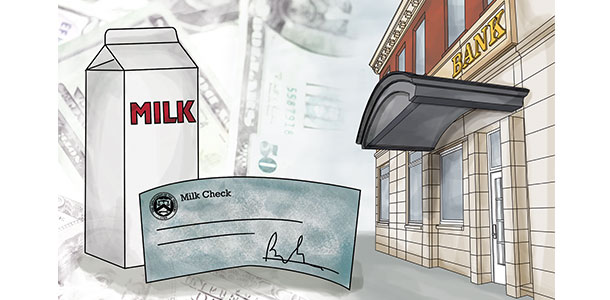Milk checks in 2014 look like they will more than cover my feed and operating expenses. Since this hasn’t happened for some time, and since I’m still gun-shy after 2009, how much cash should I hold liquid in a bank account after I pay some bills and build back a little equity? What should I do?

Bob Matlick
Partner
Frazer, LLP
The answer to this question will vary as to each operation and that operation’s debt levels. If the operation has little or no debt, they are most likely in a position that enables them to borrow on their existing lines of credit should the volatility in income and expenses cause for a negative margin.
Therefore, those types of operations would have little need to build a cash position. I would encourage them to look at building inventories or perhaps diversifying into other agriculture commodities that have volatility cycles that may run counter to dairy cycles. Even investments into other assets outside of agriculture may be worth considering.
If the operation has moderate to heavy leverage, the ability to borrow on their existing lines of credit or utilize collateral not encumbered becomes limited when margins turn negative.
A $3-per-hundredweight negative margin on a 2,500-cow dairy is approximately $160,000 per month with gross monthly income of approximately $1 million. A six-month reserve for that negative margin would be a $1 million reserve in cash or assets readily convertible to cash (feed).
As an alternative to reserving cash, I would encourage a producer to work on efficiencies within the operation to lower cost of production for a pound of milk and establish a strong working relationship with their lender including documented contingency plans for negative margins, inventorying feed at an adequate level and keeping vendors current.
I would also avoid any large-scale expansion or capital improvements and develop a strong risk management plan for both inputs and outputs.

Gary Genske
Partner/Accountant
Genske, Mulder & Co LLP
The question, as asked, can have many different answers, all depending on a variety of other individual factors. The number one concern I have for the long-term sustainability of a dairy farm is bank debt reduction, and this assumes that all other operational activities of the dairy farm are well under control.
The question of “how much cash should be held in a bank account for liquidity concerns” depends on current bank debt levels. If there is no bank debt on the dairy farm, accumulating $1,000 per cow in safe bank accounts would allow this dairy farmer to survive another 2009 loss year. The average dairy farm in 2009 lost about $1,000 per cow from operations in that year alone.

Since the debt levels on the average dairy farm are currently at their highest levels in my 40-plus years working for this industry, I strongly encourage debt reduction as the way to build equity. If I have a choice of either putting funds in a savings account or paying off bank debt, I suggest paying off the bank loans.
Also, there may exist bank loan covenants or restrictions against withdrawing working capital from the dairy operation. You may have to seek bank approval to move funds out of the dairy account and into a savings account that is outside of the bank’s control.
Louis Sander
Middle Market Agribusiness
KeyBank
The short answer is to hold as much cash as you can as liquid in a bank account. Cash equals flexibility. Ideally, you should have a two-to-one ratio of current assets to current liabilities. That is, keep twice the current assets on your balance sheet as you have in current liabilities.
One good goal is to have at least 12 months of loan principal and interest payments on hand. Another goal is eliminating any high-cost debt. Your banker can help you find the right balance by talking through your current balance sheet and anticipated opportunities.
As you know, dairying is a capital-intensive industry. You need to keep cash on hand to cover the cost of upcoming and necessary expenses such as maintaining and replacing equipment and herd. Focus on improvements to your dairy facilities and farm that have high rates of return. Be thoughtful about this and avoid random expenditures masquerading as improvement.
And as you know, dairying is a cyclical industry. You are gun-shy from 2009 – is there something you learned from that experience that you can put to use? It might help to review your 2008 cash management and think about things you’d do differently so you can protect yourself against a repeat of 2009. PD
Submit your own business management and employee relations questions by email for a panel to review.
Illustration by Kristen Phillips.







